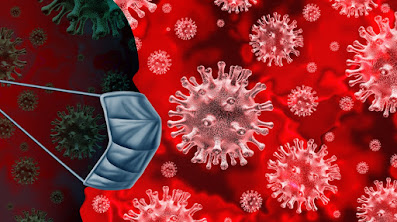- Get link
- X
- Other Apps
by
Shahriar
- Get link
- X
- Other Apps
What is Coronavirus?
The word "CORONA" came from the Latin word which means Crown, because this virus has crown-like spikes on its surface. Coronaviruses contain RNA which is a single strand. This virus can't reproduce itself until they get inside living cells and takedown living cell's mechanisms. The spikes around the virus get attached to the cells and convert these living cells into the virus-producing factory.
The RNA and other enzymes use the attached cell's molecular mechanism to produce new viruses and these new viruses get attached with other living cells and spread out the whole body of living being. In this way, the live circle of coronavirus continues.
The RNA and other enzymes use the attached cell's molecular mechanism to produce new viruses and these new viruses get attached with other living cells and spread out the whole body of living being. In this way, the live circle of coronavirus continues.
This virus was first discovered in household pets and animals ranging from livestock to wildlife such as bats. Coronavirus is referred to as a pandemic that means this is a worldwide spreading of a new disease.
 |
| Image source Google |
The Coronavirus type: Common Human Coronavirus
Around the world, people are commonly infected by this common human coronavirus.
- Alpha Coronavirus 229E
- Alpha Coronavirus NL63
- Beta Coronavirus HKU1
- Beta Coronavirus OC43
Other Types Of Coronavirus
- MERS-CoV (beta type and causes Middle East Respiratory Syndrome)
- SARS-CoV (beta type and causes Severe Acute Respiratory Syndrome)
- SARS-Cov-2 or COVID-19 (the Novel Coronavirus which causes Coronavirus Disease 2019)
How Coronavirus Spreads
This type of virus mainly spreads from person to person. When an uninfected person goes in close contact with an infected person then the virus can be spread to that person. This virus can spread through respiratory droplets when an affected person coughs or sneezes.
It also spreads from contact with contaminated surfaces or objects. This virus enters inside the body when a person touches the objects or surface that has a virus on it. Then by touching his nose, mouth and eyes too.
Symptoms Of Coronavirus
When a person is infected by the coronavirus, the symptoms may appear within 2-14 days. The following symptoms are,
- Fever and Cough
- Shortness of breath
- Inability to arouse
- Bluish lips or face
- Persistent pain or pressure in the chest
Older adults and also the people who have severe chronic medical conditions such as heart or lung disease or diabetes these people are at higher risk for getting more serious complications from the coronavirus illness.
Self-awareness:
- Always wash your hands with soap and water after you have been in a public place, or after blowing your nose, coughing, and sneezing.
- Always try to avoid touching your eyes, nose, and mouth with unwashed hands.
- Also, avoid close contact with sick people.
- Put distance between you and other people if the virus outbreaks in your community.
- Don't go outside of the home if you are sick.
- Cover coughs and sneezes and put on a facemask.
If you find this article useful then please comment below and let me know about it. Thank you for visiting this site.😊😊😊
Comments
Post a Comment